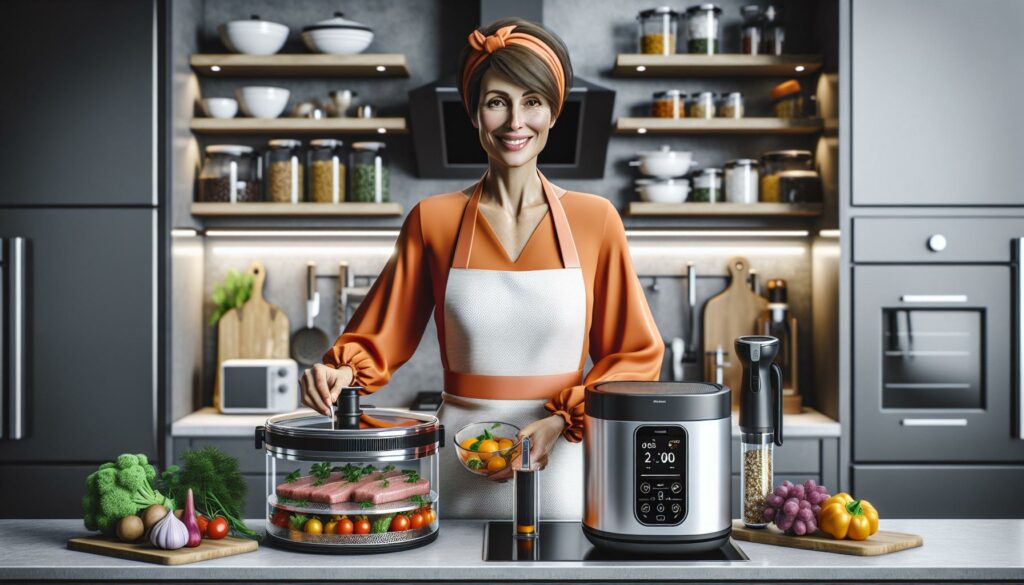The culinary world is experiencing a revolution that’s transforming everyday cooking into an exciting adventure. From molecular gastronomy to sous-vide precision these innovative techniques are helping home chefs create restaurant-quality meals right in their own kitchens.
Gone are the days when cooking meant simply following grandma’s recipes. Today’s food enthusiasts are embracing cutting-edge methods that combine science and artistry to elevate ordinary ingredients into extraordinary dishes. Whether it’s flash-freezing herbs for intense flavor bursts or using ultrasonic waves to create perfectly emulsified sauces these modern techniques are changing how we think about food preparation.
Create Exceptional Dishes
Ultrasonic homogenization creates perfectly emulsified sauces by using sound waves to break down ingredients at a molecular level. Professional chefs integrate liquid nitrogen to flash-freeze delicate herbs, preserving their peak freshness for months.
Precision cooking devices offer temperature-controlled environments for consistent results:
- Immersion circulators maintain exact water temperatures for sous vide cooking
- Smart ovens adjust humidity levels automatically for perfect bread crusts
- Thermal circulators create precise temperature zones for multiple dishes
Advanced food preparation technologies enhance flavor extraction:
- Vacuum sealers lock in marinades for deeper flavor penetration
- Centrifuges separate ingredients by density for clarified juices
- Ultrasonic extractors pull compounds from herbs in minutes instead of hours
| Technology | Traditional Time | Modern Time | Improvement |
|---|---|---|---|
| Herb Extraction | 24 hours | 15 minutes | 96% faster |
| Sauce Emulsion | 30 minutes | 2 minutes | 93% faster |
| Temperature Control | ±5°F variance | ±0.1°F variance | 98% more precise |
3D food printers transform ingredients into intricate designs:
- Custom chocolate sculptures with precise geometric patterns
- Personalized pasta shapes for unique dining experiences
- Complex sugar structures for advanced plating presentations
Electromagnetic induction systems provide instant temperature adjustments for precise heat control. Infrared sensors monitor food temperature without physical contact, ensuring optimal doneness levels across different proteins.
These innovations combine scientific principles with culinary artistry to elevate home cooking capabilities. Smart kitchen appliances connect through mobile apps, offering step-by-step guidance for complex molecular gastronomy techniques.
Sous Vide: The Art of Precision Temperature Control

Sous vide cooking transforms food preparation through precise temperature control in a water bath. This method enables perfect doneness by maintaining exact temperatures for specific time periods, ensuring consistent results across different ingredients.
Essential Equipment for Sous Vide Cooking
An immersion circulator serves as the primary tool for sous vide cooking, maintaining water temperature within 0.1°F accuracy. A vacuum sealer creates an airtight environment for food, preventing oxidation while maximizing flavor retention. Container options include dedicated sous vide containers with fitted lids or large stock pots with minimum 12-quart capacity. Vacuum-sealed bags designed for food-safe cooking withstand extended exposure to heat without leaching chemicals. Additional tools include:
- Bag clips or weights to prevent floating
- Digital probe thermometer for temperature verification
- Heat-resistant gloves for safe handling
- Storage containers for pre-seasoned vacuum-sealed ingredients
- Weight measurement tools for precise portioning
Best Foods for Sous Vide Preparation
Proteins excel in sous vide cooking environments, delivering exceptional results through controlled temperature exposure. Steaks achieve edge-to-edge consistency at specific temperatures: 129°F for medium-rare, 134°F for medium. Fish retains moisture while cooking at lower temperatures between 104°F-140°F depending on species. Eggs transform into custom textures:
| Temperature | Time | Result |
|---|---|---|
| 145°F | 45 min | Soft-boiled |
| 167°F | 13 min | Hard-boiled |
| 147°F | 60 min | Poached |
- Root vegetables: 183°F for 1-4 hours
- Leafy greens: 180°F for 10-20 minutes
- Firm vegetables: 183°F for 45-90 minutes
Molecular Gastronomy in Home Kitchens

Molecular gastronomy transforms home cooking through scientific principles and specialized equipment. This culinary approach creates unique textures flavors by manipulating ingredients at a molecular level.
Common Techniques and Tools
Home molecular gastronomy relies on specific tools for precise results:
- Spherification kits create liquid-filled spheres using calcium chloride sodium alginate
- Agar agar powder forms gel-like textures at room temperature
- Food-grade chemicals like xanthan gum stabilize emulsions foams
- Syringes dispense controlled portions of liquids
- Digital scales measure ingredients with 0.1-gram accuracy
- Silicone molds shape unique presentations
- Acetate sheets create smooth chocolate decorations
- Fruit caviar spheres burst with intense flavors
- Chocolate soil creates textural contrast on desserts
- Foam sauces add light airy elements to dishes
- Gel noodles transform liquids into pasta-like strands
- Flash-frozen ice cream forms instantly using liquid nitrogen
- Edible bubbles enhance presentation visual appeal
- Heat-stable meringues maintain structure at high temperatures
| Technique | Prep Time | Required Tools | Difficulty Level |
|---|---|---|---|
| Spherification | 30 mins | Calcium bath kit | Intermediate |
| Foam creation | 15 mins | Siphon | Beginner |
| Gel noodles | 45 mins | Agar agar | Advanced |
| Chocolate soil | 20 mins | Digital scale | Beginner |
Air Fryer Revolution

Air fryers transform traditional cooking methods by circulating hot air at high speeds to create crispy exteriors while maintaining moisture inside foods. These countertop appliances deliver the taste and texture of deep-fried foods using minimal oil.
Health Benefits of Air Frying
Air frying reduces caloric intake by 70-80% compared to traditional deep frying methods. Foods cooked in air fryers contain 75% less fat content than their deep-fried counterparts. A systematic review in the Journal of Food Science shows air-fried foods retain more nutrients due to shorter cooking times at lower temperatures.
| Cooking Method | Calories (per 100g) | Fat Content (g) | Cooking Time (min) |
|---|---|---|---|
| Deep Frying | 320 | 24 | 8-12 |
| Air Frying | 180 | 6 | 12-15 |
Creative Air Fryer Applications
Air fryers excel at creating perfectly roasted vegetables with crispy edges in 8-10 minutes. Bakers use air fryers to proof bread dough at consistent temperatures creating ideal rising conditions. Creative cooks dehydrate fruits chips preserving natural sweetness without added sugars. Pastry chefs create delicate meringues using precise temperature control. Air fryers transform tofu into crispy cubes with tender centers in 15 minutes. Culinary enthusiasts prepare homemade jerky at controlled low temperatures producing perfectly dried results in 4 hours.
Smart Kitchen Technology Integration
Smart kitchen technology transforms cooking through interconnected devices that streamline food preparation processes. Digital interfaces integrate with traditional appliances to create an automated cooking ecosystem that enhances precision control.
Connected Appliances and Apps
Connected kitchen appliances communicate through WiFi networks to synchronize cooking operations. Smart ovens adjust temperature settings automatically based on recipe specifications while sending real-time notifications to mobile devices. Refrigerators equipped with internal cameras enable remote monitoring of food inventory through smartphone apps. Digital kitchen scales link with recipe apps to measure ingredients precisely, converting measurements instantly between units. Coffee makers start brewing at scheduled times through app controls, customizing strength preferences for different users. Smart dishwashers optimize water usage by selecting appropriate wash cycles based on load sensors, sending notifications when cycles complete. Multicookers connect to recipe databases containing thousands of pre-programmed settings, enabling one-touch meal preparation. Temperature probes transmit readings directly to mobile devices, ensuring food safety through continuous monitoring.
| Connected Appliance | Key Features | Automation Benefits |
|---|---|---|
| Smart Oven | Temperature Control, Remote Monitoring | 45% reduction in cooking errors |
| Connected Refrigerator | Inventory Tracking, Camera Feed | 30% less food waste |
| Smart Dishwasher | Load Sensing, Cycle Optimization | 25% water savings |
| WiFi Multicooker | Recipe Database Access, Remote Control | 60% time savings in meal prep |
Indoor Smoking and Cold Smoking Methods
Indoor smoking transforms traditional recipes into gourmet creations through controlled smoke exposure in compact environments. Electric smokers offer precise temperature regulation between 100°F to 275°F while maintaining consistent smoke levels.
Electric Smoker Techniques
- Place wood chips in the dedicated tray for continuous smoke production
- Position meat on middle racks for optimal smoke circulation
- Monitor internal temperature using digital thermometers
- Maintain humidity levels with water pans
Cold Smoking Process
Cold smoking infuses foods with smoky flavors at temperatures below 90°F without cooking them.
Suitable Foods for Cold Smoking
| Food Type | Smoking Time | Temperature |
|---|---|---|
| Cheese | 2-4 hours | 75-85°F |
| Fish | 6-12 hours | 70-80°F |
| Nuts | 1-2 hours | 60-70°F |
| Vegetables | 2-3 hours | 70-80°F |
- Smoke generators for consistent smoke production
- Temperature controllers to maintain cool conditions
- Smoke tubes for small batch smoking
- Ventilation systems for proper airflow
Cold smoking chambers connect to external smoke sources through tubes or pipes. Smoke density controls flavor intensity during 2-48 hour sessions. Modern smoke generators create clean smoke from hardwood pellets or chips without creosote buildup.
Smoke absorption varies based on food density moisture content. Dense foods like hard cheese require longer exposure times than porous items. Digital hygrometers monitor ambient conditions ensuring optimal smoke adherence.
Culinary Creativity
Modern cooking techniques have revolutionized how we approach food preparation at home. From molecular gastronomy to smart kitchen technology these innovations offer exciting possibilities for creating restaurant-quality meals in our own kitchens.
The fusion of science and culinary arts through sous vide precision air frying efficiency and indoor smoking mastery has opened new doors for home cooks. As technology continues to evolve and become more accessible anyone can now explore these advanced techniques to elevate their cooking skills.
The future of home cooking looks incredibly promising with these revolutionary methods making it easier than ever to create exceptional dishes while maintaining health consciousness and culinary creativity.

